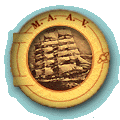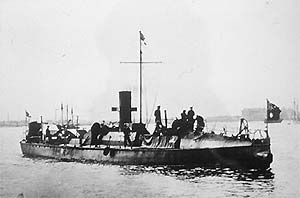|
|

|
||||||
|

|
![]() n 1983 members of the Maritime Archaeology Association of Victoria uncovered the remains of a second-class torpedo boat believed to be the Lonsdale at Queenscliff, Victoria. The Victorian Government purchased two second-class torpedo boats the Lonsdale and Nepean and one first-class torpedo boat the Childers from J.I. Thornycroft and Co. of Church Wharf, Chiswick, England, in 1882. A third second-class boat the Gordon was purchased from J.S. White and Co. of Cowes on the Isle of Wight in 1885; and a second first-class boat the Countess of Hopetoun was purchased from A. Yarrow and Co. of Poplar, London in 1890. These boats form a unique series illustrating the development of torpedo warfare and fast fighting boats in Australia during the nineteenth century.
n 1983 members of the Maritime Archaeology Association of Victoria uncovered the remains of a second-class torpedo boat believed to be the Lonsdale at Queenscliff, Victoria. The Victorian Government purchased two second-class torpedo boats the Lonsdale and Nepean and one first-class torpedo boat the Childers from J.I. Thornycroft and Co. of Church Wharf, Chiswick, England, in 1882. A third second-class boat the Gordon was purchased from J.S. White and Co. of Cowes on the Isle of Wight in 1885; and a second first-class boat the Countess of Hopetoun was purchased from A. Yarrow and Co. of Poplar, London in 1890. These boats form a unique series illustrating the development of torpedo warfare and fast fighting boats in Australia during the nineteenth century.
To date, the hulls of two of these vessels have been located. The Countess of Hopetoun rests in shallow water off Swan Island, Victoria and what is believed to be the Lonsdale lies buried in 0.75 to 1.0 metre of sand on reclaimed land some 300 metres from the present foreshore at Queenscliff, Victoria. The hull of the Lonsdale straddles the dividing line between two properties, approximately one third of it being in the land occupied by the Queenscliffe Maritime Centre and Museum whilst the other two thirds is in the adjoining property occupied by the Port of Geelong Authority's Queenscliff Buoy Depot.

|
Photos courtesy Heritage Victoria's, Maritime Heritage Unit. |
A preliminary assessment of the Lonsdale's cultural significance is being undertaken as part of an overall conservation plan for this vessel. The cultural significance of a vessel may be defined as its aesthetic, historic, scientific or social value for past, present or future generations and is embodied in its physical material, its contents, its function, its setting, associated records and the responses it evokes (The National Committee on Engineering Heritage of the Board of Engineering, 1992).
The method used to assess the cultural significance of the Lonsdale is that of Kerr (Kerr, 1990) and is based upon a detailed analysis of the documentary and physical evidence. This is an essential first step in the development of a conservation plan for these vessels. As very little has been written on this subject, this project will involve a detailed analysis of primary reference material available within Australia and overseas. This analysis will be divided into four separate stages: HMVS Lonsdale, Naval Historical Society.
Stage one will concentrate on material available within the Australian Archives (Vic), the Victorian State Government Archives, The Museum of Victoria, contemporary journals such as The Engineer, Engineering, Brassey 's Naval Annual, Transactions of the Institution of Naval Architects, Altnanach fur die k, K. Kriegs-marine, Durssier and Valentino 's Aide-Memoire de / 'Officer de Marine, Lloyd's Warships of the World, The Illustrated London News, Iron, The Broad Arrow, The Army and Navy I/lust rated, The United Services Gazette, Le Yacht, Mittheilunge aus Gebiete des Seewesens, the Revista Maritina, and contemporary newspapers such as The Times.
Stage two will be a survey of archival material available in collections outside Victoria but within Australia, namely: The Queensland State Government Archives; The Australian Archives (A.C.T.); The National Library (A.C.T.); The Royal Australian Navy Historical Collection (A.C.T.); The Australian War Memorial; The Mitchell Library (N.S.W.); The National Maritime Museum (N.S.W.); The New South Wales State Government Archives. It is hoped that the survey in N.S.W. will also provide us with details of the Acheron and Avernus (82'6" x 10'6", 22 tons displacement), designed by Norman Selfe and built by the Atlas Engineering Company of Pyrmont. Previous research indicates that only a limited amount of material relating to the torpedo boat purchased by the Tasmanian Government is available in their archives in Hobart.
Stage three will be a survey of archival material available in collections outside Australia, namely: the Ministry of Defence Library (U.K.); The Royal United Services Institute (U.K.); The Royal Navy Historical Collection (U.K.); The Colonial Office (U.K.); The Science Museum (U.K.); H.M.S. Vernon (U.K.); H.M.S. Dolphin (U.K.); The Royal Naval Engineering College (U.K.); The Imperial War Museum (U.K.); The Royal Naval Museum Portsmouth (U.K.); The National Maritime Museum Greenwich (U.K.) which holds the archives of J.I. Thornycroft and A. Yarrow's archives in Glasgow.
Stage four will involve the analysis of the material collected in stages one to three providing us with a data base that can be used to establish the historical significance of the Lonsdale and the other torpedo boats purchased by the Victorian Government.
References![]()
![]()
James Semple Kerr, The Conservation plan, The National Trust of Australia (NSW),
Sydney, 1990, p.3.
The Institution of Engineers, Australia, Engineering Heritage & Conservation
Guidelines, The Institution of Engineers, Australia, ACT, 1992, p.5.